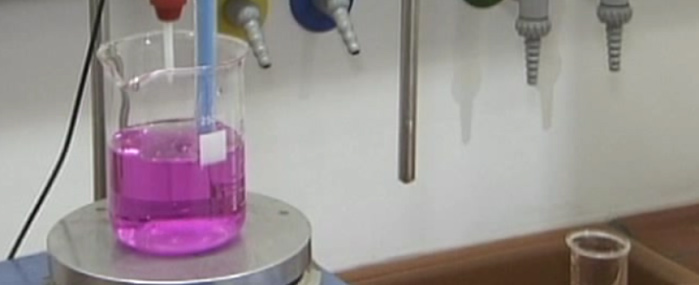
Direct Links:
Titration
To perform the titration a burette with calibrated milliliter scale is fastened using a burette clamp. In addition to this, a magnetic stirrer is used to ensure the mixing of the solution. Whenever performing a quantitative experiment it is important to work precisely, e.g. a volumetric pipette should be used to measure liquids in order to keep errors to a minimum.
The substance used to titrate has a well known concentration and by determining the amount of substance needed, the concentration of the unknown solution can be calculated. To illustrate the process, an acid-base titration is performed, where an acid of unkown concentration is titrated using a base of known concentration.
The burette is filled with caustic soda using a funnel, which has to be removed afterwards to prevent it from distorting the scale of the burette. The meniscus is lowered to match 0 on the scale and the excessive caustic soda is collected in a beaker. Afterwards the beaker is substituted with a clean beaker. 10 mL of the sample are poured into the beaker using a volumetric pipette.
A digital pH-meter or an indicator can be used to monitor the pH-value of a acid-base titration. An indicator can change its color according to the pH-value of the solution. In this example phenolphthalein and a pH-meter is used to monitor the pH-value.
The electrode of the pH-meter is stored in a cap filled with a solution of potassium chloride and should never run dry. Therefore it should be stored in a liquid if not used, preferably in a solution of potassium chloride. Before calibrating or using the electrode it has to be rinsed with demineralized water. To calibrate the electrode, it is plunged into a solution of pH-value 4 and the same value has to be set on the pH-meter. Afterwards it is rinsed and calibrated again using a solution of pH-value 7. Now the electrode can be fastened to the apparatus. Demineralized water can be added to the solution to ensure the electrode plunges in deep enough without touching the magnetic stirrer. After adding a few drops of phenolphthalein the titration can start.
The magnetic stirrer is turned on and the base can be added in sections of 1 mL. A pause after adding some base is necessary to reach the equilibrium of the acid-base reaction. When repeating the titration, the chunks around the endpoint have to be scaled down in order to determine the endpoint accurately.
The increase of the pH-value can be monitored using the pH-meter. In addition to this, the indicator will remain colored for a short amount of time when approaching the endpoint. After reaching the endpoint, the indicator is colored permanently. A small drop of base is sufficient to increase the pH-value by a considerable amount and therefore cause the indicator to change color.
The amount of acid in the solution of unknown concentration is equal to amount of base used to reach the endpoint and can be calculated. Principally multiple titrations should be performed to reduce errors.